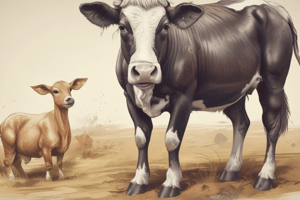Podcast
Questions and Answers
What is the term for a castrated horse?
What is the term for a castrated horse?
- Steer
- Capon
- Geld (correct)
- Colt
Castration can improve meat quality by making it more tough.
Castration can improve meat quality by making it more tough.
False (B)
What is the preferred age for castrating a bull?
What is the preferred age for castrating a bull?
3-4 months
A castrated sheep is called a ______.
A castrated sheep is called a ______.
What is one advantage of castration in animals?
What is one advantage of castration in animals?
Castration can promote weight gain in meat animals.
Castration can promote weight gain in meat animals.
What is a common method used for bloodless castration in cattle?
What is a common method used for bloodless castration in cattle?
The surgical method of castration in horses occurs when the animal is between ______ months old.
The surgical method of castration in horses occurs when the animal is between ______ months old.
What is the main objective of caponization in poultry?
What is the main objective of caponization in poultry?
Flashcards
Castration of Animals
Castration of Animals
Surgical or non-surgical removal of animal testes, leading to testicular atrophy.
Colt (Horse)
Colt (Horse)
An un-castrated male horse.
Gelding (Horse)
Gelding (Horse)
A castrated male horse.
Steer (Beef Cattle)
Steer (Beef Cattle)
Signup and view all the flashcards
Capon (Poultry)
Capon (Poultry)
Signup and view all the flashcards
Wether (Sheep)
Wether (Sheep)
Signup and view all the flashcards
Burdizzo
Burdizzo
Signup and view all the flashcards
Elastrator and Rubber Ring (Banding)
Elastrator and Rubber Ring (Banding)
Signup and view all the flashcards
Caponization
Caponization
Signup and view all the flashcards
Castration Age Considerations
Castration Age Considerations
Signup and view all the flashcards
Study Notes
Animal Castration: Definitions and Types
- Castration is the surgical removal of testes (testicles) or their destruction through non-surgical techniques, leading to testicular atrophy. This is often done using tools designed specifically for the purpose.
Indications for Castration
- Animal Behavior: Making the animal docile. Managing the animal more easily, particularly where females are present.
- Preventing Unwanted Breeding: Preventing unwanted or unwanted offspring, controlling population.
- Treatment and Correction: Addressing some medical conditions or problems.
- Enhancement of Meat Production: Improving weight gain in livestock (meat animals). Improving the quality of the meat, making it more tender and flavorful.
Castration of Different Animal Types (Detailed Examples):
1. Horses:
- Terminology: An uncastrated horse is called a colt. A castrated horse is called a gelding.
- Objective: To calm the animal, essential for handling and management.
- Age: Typically castrated between 12-24 months old.
- Method: Surgical only (no non-surgical methods are used)
2. Beef Cattle:
- Terminology: A castrated bull is termed a steer.
- Objective: Improve meat quality, influencing juiciness, tenderness, and color.
- Age: Any age, but optimal results often achieved between the ages of 3 and 4 months old.
- Season: Commonly done during spring or fall.
- Methods: Both surgical (open, bloody) and non-surgical (closed, bloodless) methods are viable. Non-surgical methods include burdizzo, elastrator, and rubber ring banding.
3. Sheep:
- Terminology: A castrated sheep is a wether.
- Objective: Enhances meat and wool quality.
- Age: Usually done between 2-4 weeks of age (2w).
- Season: Preferably during spring and summer.
- Methods: Both surgical (bloody) or non-surgical (bloodless) techniques. Non-surgical includes burdizzo, elastrator, rubber rings, knife and a tool known as an emasculator. Surgical incisions using knives may lead to post-castration infection. Non-surgical methods are preferable for minimizing complications.
4. Poultry:
- Terminology: Male chickens have capons for castrated males.
- Objective: Capons produce more tender, juicy meat.
- Age: Usually castrated between 2 and 4 weeks old.
- Procedure: Known as caponization.
Instruments and Methods for Castration:
Burdizzo (Emasculatome)
- Method: Crushing of the spermatic cord and blood vessels.
- Attributes: Bloodless method, minimal scrotum sloughing, typically applied about 2-5 cm above each testicle.
Elastrator and Rubber Rings
- Method: Cutting off blood circulation to testicles and scrotum. The scrotum will atrophy and slough within 3-4 weeks post-procedure.
- Advantages: Suitable for relatively young animals, relatively inexpensive.
- Disadvantages: Risk of tetanus, infection, and less appropriate for older animals.
Surgical Castration
- Method: Removal of the testes through a surgical incision.
- Attributes: High degree of certainty in completion of the castration, requires sharp tools.
- Disadvantages: Higher risk of blood loss, infection, open wounds, and increased safety risk for the handler due to using sharp blades.
Studying That Suits You
Use AI to generate personalized quizzes and flashcards to suit your learning preferences.
Related Documents
Description
Explore the definitions, types, and reasons behind animal castration in this quiz. Learn about its impact on animal behavior, breeding control, and meat production across various species, including horses. This quiz is essential for veterinary students and animal caretakers.




